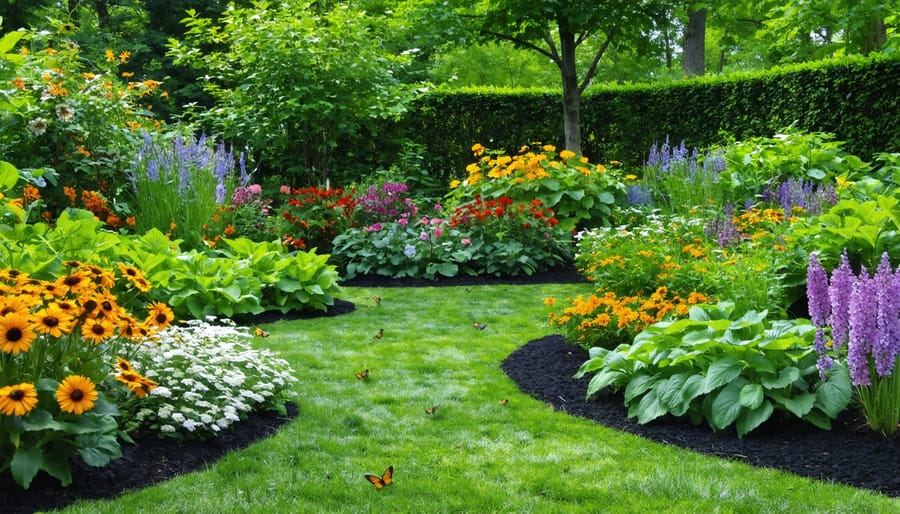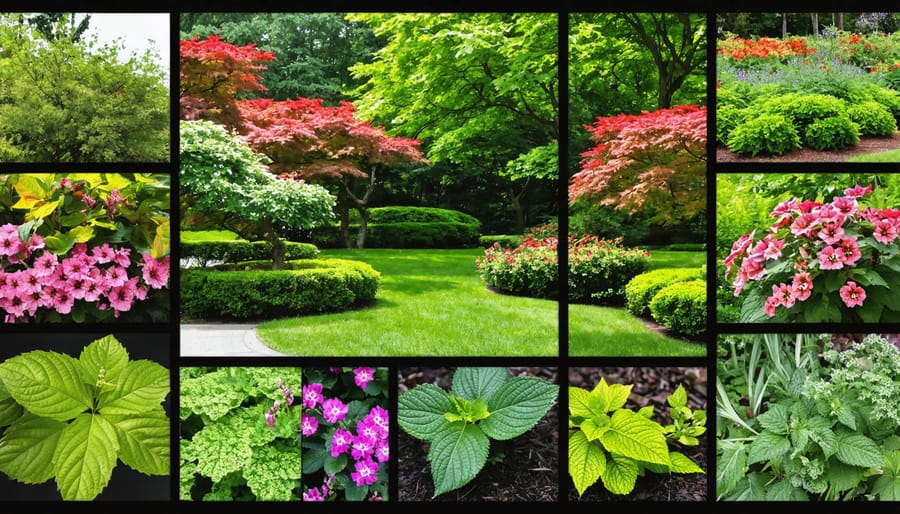Transform your outdoor space into a living masterpiece by strategically placing ornamental trees that create year-round visual interest while supporting local wildlife. These architectural elements of nature do more than just beautify – they frame views, provide privacy screens, and establish focal points that guide the eye through your landscape design. From the delicate spring blossoms of flowering dogwoods to the brilliant autumn display of Japanese maples, ornamental trees offer endless possibilities for creating dynamic, sustainable landscapes that evolve with each passing season.
Whether you’re designing a new garden or enhancing an existing space, the thoughtful selection and placement of ornamental trees can dramatically elevate your property’s aesthetic appeal while increasing its environmental value. These versatile plants serve as natural air purifiers, provide essential habitat for birds and beneficial insects, and help manage stormwater runoff – all while adding structure and sophistication to your outdoor sanctuary.
Consider your space’s unique characteristics – sunlight patterns, soil conditions, and existing architecture – as you embark on this rewarding journey of creating a landscape that blends beauty with ecological responsibility. With proper planning and care, your ornamental tree selections will grow into lasting investments that enhance both your property value and quality of life.
Choosing the Right Ornamental Trees for Sustainable Landscapes
Native vs. Non-Native Species
When planning your landscape with stunning ornamental trees, one of the most important decisions you’ll face is choosing between native and non-native species. Native trees have evolved alongside local wildlife and are naturally adapted to your region’s climate and soil conditions. They typically require less maintenance, support local pollinators, and provide food and shelter for native birds and insects.
However, don’t feel limited to native species alone. Many non-native trees can also thrive in your landscape when properly selected. These adapted species can offer unique ornamental features, such as unusual flower colors or distinctive leaf shapes, that might not be available among native options. The key is ensuring they’re well-suited to your growing zone and won’t become invasive in your area.
Consider mixing both native and non-native trees in your landscape for the best of both worlds. For example, you might pair a native flowering dogwood with a Japanese maple, creating visual interest while still supporting local ecology. Before selecting any tree, research its growth habits and maintenance requirements, and check with local extension offices or garden centers to ensure it’s not considered invasive in your region.
Remember that successful landscaping isn’t just about aesthetics – it’s about creating a sustainable environment that enhances both your property and the local ecosystem. Whether native or non-native, choose trees that match your maintenance capabilities and environmental goals.
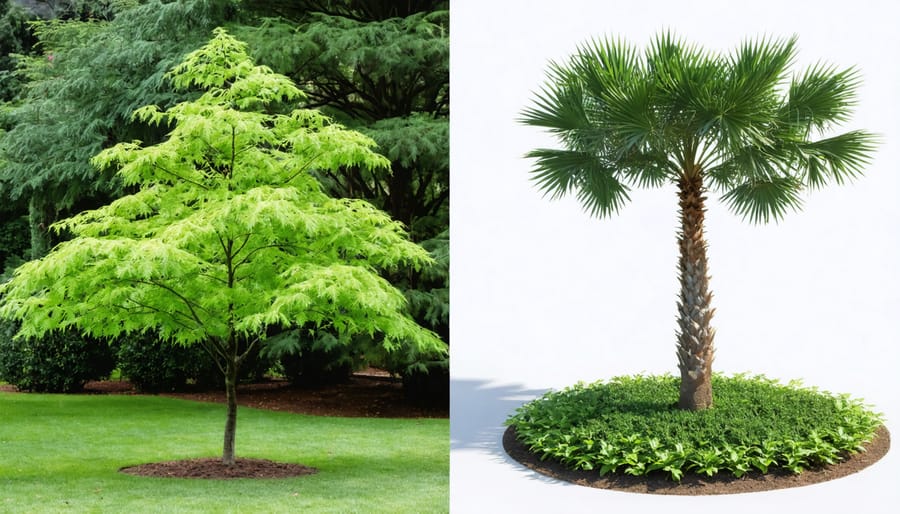
Water-Wise Tree Selection
In today’s climate-conscious world, choosing drought-tolerant ornamental trees isn’t just environmentally responsible – it’s smart gardening. These resilient beauties can transform your landscape while keeping your water bills in check and reducing maintenance needs.
Several stunning options stand out for their water-wise qualities. The Crape Myrtle, with its vibrant summer blooms and attractive bark, thrives in hot, dry conditions. Desert Willow offers delicate, trumpet-shaped flowers and requires minimal irrigation once established. For year-round interest, consider the Chinese Pistache, known for its spectacular fall colors and exceptional drought tolerance.
Native trees are particularly well-suited for water-conscious landscaping. They’ve naturally adapted to local rainfall patterns and typically need little supplemental watering after their establishment period. The Eastern Redbud, for instance, delivers stunning spring blossoms while being remarkably drought-resistant.
To ensure success with water-wise trees, focus on proper establishment during the first year. Deep, infrequent watering encourages roots to grow deep into the soil, making trees more resilient during dry spells. Adding a thick layer of mulch around your trees (keeping it away from the trunk) helps retain moisture and reduce evaporation.
Remember, even drought-tolerant trees need regular watering during their first growing season. After that, they’ll reward you with years of low-maintenance beauty while helping conserve our precious water resources.
Smart Placement for Long-Term Success
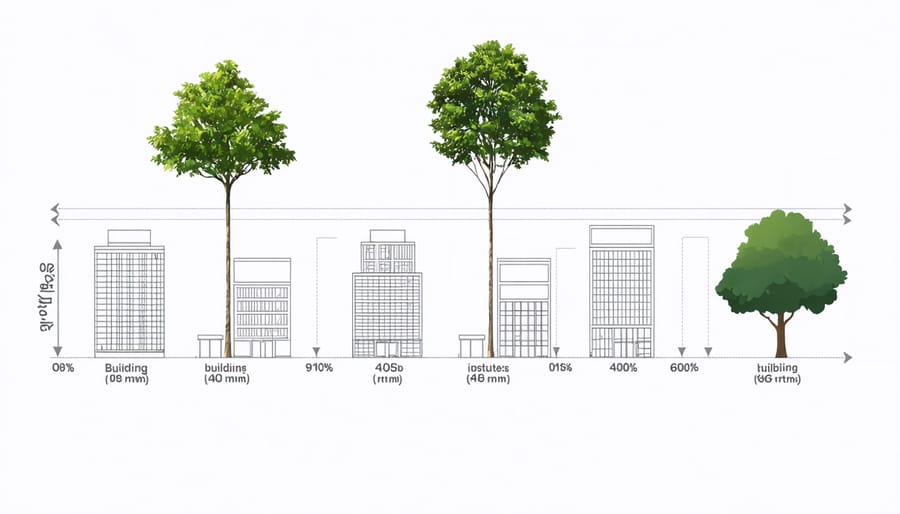
Understanding Growth Patterns
One of the most common mistakes in landscaping with ornamental trees is underestimating their mature size. That beautiful Japanese maple that looks perfect near your front door today might overwhelm the space in just a few years. Understanding growth patterns is essential for successful long-term planning.
Start by researching the mature height and spread of your chosen species. Most ornamental trees come with tags indicating their expected size, but remember these are averages – growing conditions can affect final dimensions. Consider the tree’s natural shape too; some grow tall and columnar, while others spread wide with horizontal branches.
Think in three dimensions when planning. Visualize not just the height and width, but also how the canopy will develop. Will it create desired shade patterns? Could it eventually interfere with power lines or building structures? Factor in growth rate as well – fast-growing trees like river birch will reach maturity quicker than slow-growing species like dogwood.
Remember to account for root spread, which often extends well beyond the canopy. A good rule of thumb is to multiply the mature canopy width by 1.5 to estimate the root zone. This helps you space trees appropriately and avoid conflicts with hardscaping or underground utilities.
Give your trees room to achieve their natural form. Proper spacing now prevents costly removal or aggressive pruning later, allowing your landscape to mature gracefully while maintaining its intended design.
Creating Beneficial Microclimates
Ornamental trees can be strategically placed to create delightful microclimates in your garden, offering natural solutions for temperature control and wind protection. By thoughtfully positioning deciduous trees on the southern and western sides of your home, you’ll enjoy cooling shade during hot summer months while allowing warming sunlight to penetrate during winter when leaves have fallen.
Creating a windbreak is another valuable benefit of ornamental trees. Plant medium to tall varieties in a staggered formation on the windward side of your property to reduce cold winter winds and protect more delicate plants. Consider columnar varieties like Italian Cypress or fastigiate Oak for narrow spaces where wind protection is needed.
The shade cast by ornamental trees also helps create perfect conditions for shade-loving plants beneath their canopy. This natural umbrella effect creates a cooler, more humid environment where woodland plants like ferns and hostas can thrive. Additionally, these shaded areas make wonderful outdoor living spaces, perfect for placing benches or creating peaceful reading nooks.
For small gardens, even a single well-placed ornamental tree can make a significant difference. A Japanese Maple or Dogwood positioned near a patio can provide the perfect amount of dappled shade for outdoor dining while adding seasonal interest with their changing foliage and flowers.
Remember that microclimates develop gradually as trees mature, so planning for future growth is essential when designing your landscape. Consider the ultimate size and shape of your chosen trees to ensure they’ll provide the desired effect without overwhelming the space.
Sustainable Maintenance Practices
Natural Pruning Techniques
Natural pruning emphasizes working with your tree’s inherent growth patterns rather than forcing an artificial shape. When pruning ornamental trees properly, you’ll want to observe their natural form and make cuts that enhance their inherent beauty.
Start by removing any dead, damaged, or diseased branches, as these can harm the tree’s overall health. Next, look for crossing branches that rub against each other – these can create wounds and invite disease. Remove the weaker of the two branches, making clean cuts just above the branch collar.
Thinning out dense areas of the canopy helps promote better air circulation and light penetration, which is essential for healthy growth. Rather than topping or shearing your trees into artificial shapes, focus on selective pruning that maintains the tree’s natural silhouette while controlling its size.
Timing is crucial for natural pruning. Most ornamental trees benefit from pruning during their dormant season, typically late winter or early spring. However, spring-flowering trees should be pruned right after they finish blooming to avoid removing next year’s flower buds.
Remember to step back frequently while pruning to assess your work from different angles. This helps ensure you maintain balance and symmetry while preserving the tree’s natural character. Small, regular pruning sessions are often more beneficial than dramatic periodic cutting, allowing your tree to adapt gradually to changes while maintaining its natural grace.
Organic Fertilization
Nourishing your ornamental trees naturally is one of the most rewarding aspects of sustainable landscaping. Organic fertilization not only promotes healthy growth but also supports the entire ecosystem in your garden. The key to successful soil management for trees lies in understanding and implementing natural fertilization methods.
Start by creating your own compost using fallen leaves, grass clippings, and kitchen scraps. This “black gold” provides a perfect blend of nutrients while improving soil structure. Apply a 2-3 inch layer of compost around your trees’ drip line each spring, being careful not to pile it against the trunk.
Consider incorporating these organic materials into your fertilization routine:
– Well-aged manure from herbivorous animals
– Bone meal for phosphorus
– Kelp meal for micronutrients
– Wood ash (sparingly) for potassium
Remember to maintain a healthy layer of mulch around your trees. This natural approach not only feeds your trees slowly and steadily but also encourages beneficial soil organisms. These tiny helpers break down organic matter and create a thriving underground network that supports your trees’ health.
For best results, observe your trees throughout the seasons. Yellowing leaves or stunted growth might signal the need for specific nutrients, which you can address through targeted organic amendments. This gentle, sustainable approach helps create resilient trees that will enhance your landscape for years to come.
Water Conservation Strategies
Water conservation is essential when landscaping with ornamental trees, and implementing smart irrigation strategies can help maintain beautiful trees while being environmentally responsible. Start by grouping trees with similar water needs together, a practice known as hydrozoning, which allows for more efficient watering schedules.
Consider installing a drip irrigation system around your ornamental trees. These systems deliver water directly to the root zone, reducing waste through evaporation and ensuring deep root growth. Adding a timer to your irrigation system helps maintain consistent watering schedules and prevents overwatering, especially during pre-dawn hours when water loss through evaporation is minimal.
Mulching is another excellent water-saving technique. Apply a 2-3 inch layer of organic mulch around your trees, keeping it away from the trunk. This helps retain soil moisture, reduces water evaporation, and suppresses water-hungry weeds. Choose materials like wood chips, shredded bark, or leaves for the best results.
Monitor soil moisture regularly using a simple moisture meter or the finger test. Insert your finger about 2 inches into the soil – if it feels dry at that depth, it’s time to water. During establishment, most ornamental trees need regular watering, but once established, many species can thrive with minimal supplemental irrigation.
Consider collecting rainwater in barrels or installing a rain garden to maximize natural water resources. These sustainable practices not only conserve water but also provide your trees with chemical-free irrigation options.
Companion Planting with Ornamental Trees
Companion planting isn’t just for vegetable gardens – it’s equally important when landscaping with ornamental trees. Creating thoughtful plant combinations can enhance your year-round tree garden design while supporting local wildlife and improving soil health.
When selecting companions for your ornamental trees, consider plants that work in layers. Start with shade-loving shrubs like hydrangeas or rhododendrons that thrive under the tree’s canopy. These middle-layer plants create visual interest and provide shelter for birds and beneficial insects.
At ground level, woodland perennials make excellent companions. Plants like hostas, ferns, and wild ginger naturally grow in forest settings and will flourish beneath your ornamental trees. These understory plants help prevent soil erosion and create a lush, natural look.
Consider adding spring bulbs like daffodils and snowdrops around your trees. They’ll bloom before the tree’s leaves fully emerge, adding early-season color to your landscape. Plus, their foliage dies back naturally just as other plants begin to grow.
Native plants are particularly valuable companions as they’ve evolved alongside local tree species. They attract native pollinators and create natural habitat corridors. Try pairing your ornamental cherry with native bleeding hearts, or plant wild geraniums under your Japanese maple.
Remember to leave some space between companions and your tree’s trunk to prevent competition and moisture issues. A good rule of thumb is to maintain a small mulch ring immediately around the trunk, then gradually transition to companion plants.
Some fantastic combinations include:
– Dogwood trees with native woodland phlox and foam flower
– Crabapple trees surrounded by spring bulbs and hardy geraniums
– Japanese maples paired with autumn ferns and coral bells
– Flowering plum trees complemented by hellebores and lily-of-the-valley
By thoughtfully selecting companion plants, you’ll create a more resilient landscape that supports local biodiversity while looking beautiful throughout the seasons.
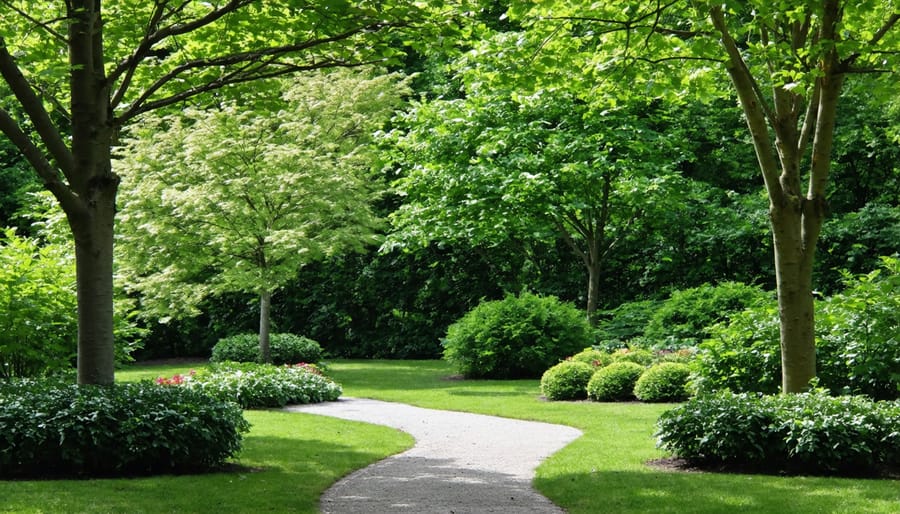
Landscaping with ornamental trees offers endless possibilities to create stunning outdoor spaces while contributing to environmental sustainability. By choosing native species, considering mature sizes, and planning for seasonal interest, you can develop a landscape that brings joy throughout the year while supporting local ecosystems. Remember to maintain proper spacing, implement regular pruning schedules, and use sustainable watering practices to ensure your trees thrive for generations to come. As you embark on your landscaping journey, consider the long-term impact of your choices – not just on your property, but on the environment as a whole. With thoughtful planning and proper care, your ornamental trees will create a lasting legacy of beauty, shade, and habitat for wildlife, making your outdoor space truly extraordinary while promoting a healthier planet for future generations.


